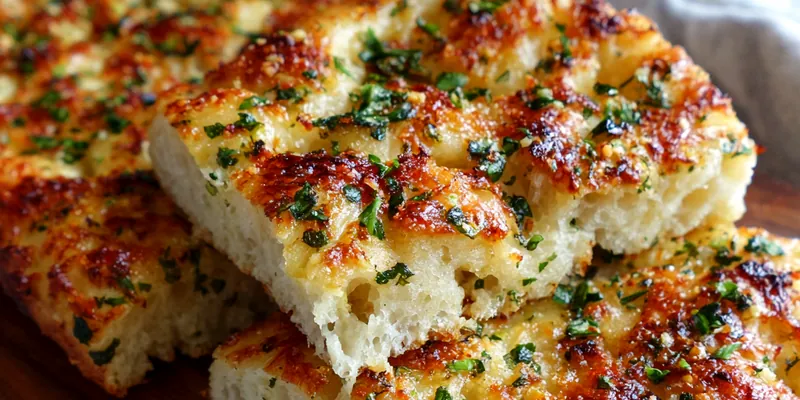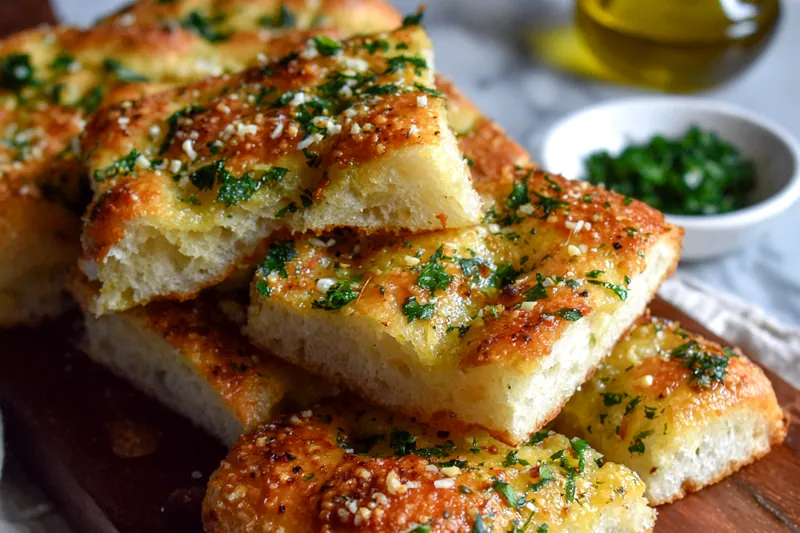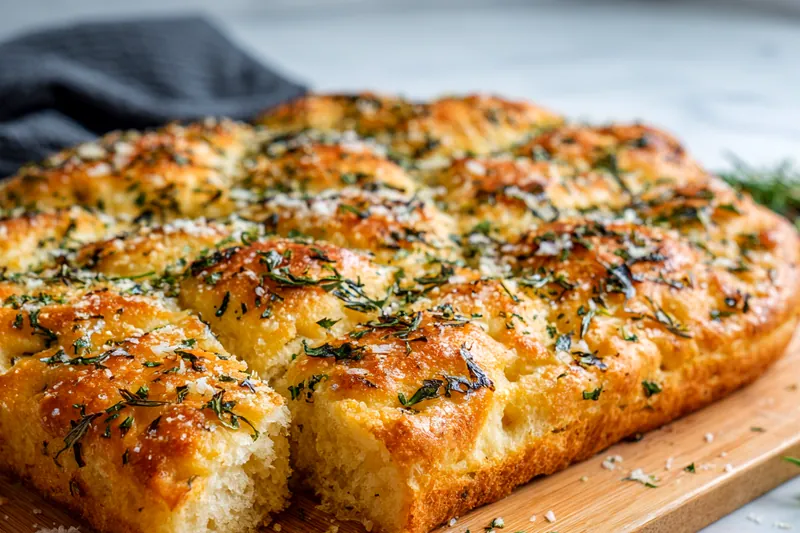Garlic Parmesan Focaccia Bread
Fluffy homemade garlic Parmesan focaccia bread with golden crust, aromatic herbs, and dimpled texture. Perfect for dipping or serving alongside Italian meals.

Understanding Focaccia Dough Texture
Focaccia dough differs from other bread doughs in its higher hydration and softer texture. The key is achieving a balance between structure and tenderness - the dough should be sticky enough to create the characteristic airy crumb but strong enough to hold its shape during rising.
The distinctive dimpled surface isn't just decorative; it creates pockets that hold olive oil and toppings while preventing the bread from rising too much during baking. This technique ensures the focaccia maintains its traditional flat profile with maximum flavor.
💡 Professional Tip
Don't overwork the dough - focaccia should have an irregular, rustic texture. The stickiness that feels wrong for other breads is exactly what creates focaccia's signature light, airy interior.
Frequently Asked Questions
Common causes include old yeast, insufficient rising time, or overworking the dough. Make sure your yeast foams during activation and allow full rising times even if it takes longer.
Yes! After the first rise, you can refrigerate the dough for up to 24 hours. Bring to room temperature and allow the second rise before baking.
Use oiled fingertips to press straight down through the dough to the bottom of the pan. Don't be gentle - you want deep dimples that will hold the olive oil and toppings.
You can use a round pizza stone, cast iron skillet, or even a rimmed baking sheet. Just adjust the thickness - thinner focaccia will bake faster, thicker will need more time.
Store covered at room temperature for 2-3 days. For longer storage, slice and freeze. Reheat in a 350°F oven for 5-8 minutes to restore crispness.
Absolutely! Cherry tomatoes, olives, caramelized onions, or different herbs all work beautifully. Add delicate toppings in the last 10 minutes of baking to prevent burning.
Use plenty of olive oil in the pan and on your hands when shaping. The oil prevents sticking and contributes to the crispy bottom crust that's characteristic of good focaccia.
The focaccia should be golden brown on top and sound hollow when tapped on the bottom. Internal temperature should reach 200°F (93°C) for fully baked bread.
Recipe Troubleshooting Guide
Soggy Bottom
Problem: Focaccia has a soggy or pale bottom
Solution: Use enough oil in the pan, bake on the lower oven rack, and ensure oven is fully preheated. A pizza stone can help create a crispier bottom.
Burnt Toppings
Problem: Garlic or cheese burns before bread is done
Solution: Cover with foil if toppings brown too quickly, or add delicate toppings halfway through baking. Lower oven temperature by 25°F if needed.
Flat, Dense Texture
Problem: Focaccia doesn't rise properly and is dense
Prevention: Check yeast freshness, ensure proper rising temperature (75-80°F), and don't skip the dimpling step which helps create the airy texture.
Dough Too Sticky
Problem: Dough is unmanageably sticky during shaping
Recovery: Oil your hands and work surface generously. Focaccia dough should be sticky - resist adding too much flour which will make it dense.
Uneven Browning
Problem: Some areas brown much faster than others
Prevention: Rotate the pan halfway through baking, ensure even dimpling and oil distribution, and check that your oven doesn't have hot spots.
Flavor Balance Issues
Too Sweet: Add more garlic, herbs, or a pinch of red pepper flakes
Too Salty: Balance with a drizzle of honey or serve with sweet butter
Bland: Increase garlic and herbs, use more flaky salt on top, or finish with herb-infused olive oil

Choosing Premium Focaccia Ingredients
Quality olive oil is essential for authentic focaccia - it's used in the dough, for shaping, and as a finishing touch. Extra virgin olive oil provides the fruity, peppery notes that make focaccia so distinctive. Don't skimp on this ingredient as it directly impacts flavor.
Fresh garlic and high-quality Parmesan cheese elevate this simple bread into something special. The garlic should be minced fine to distribute evenly and prevent burning, while freshly grated Parmesan melts better and provides superior flavor to pre-grated options.
Essential Ingredient Notes
- Olive Oil Quality: Use the best extra virgin olive oil you can afford. It's a main flavor component, not just a cooking fat. Look for oil with a harvest date within the last year.
- Flour Selection: All-purpose flour works perfectly for focaccia's tender crumb. Bread flour can be used but may result in a chewier texture than traditional focaccia.
- Herb Freshness: Fresh rosemary provides the best flavor and aroma. If using dried herbs, use half the amount and add them to the dough rather than just the topping.

Mastering Focaccia Baking Technique
The secret to perfect focaccia lies in understanding when to be gentle and when to be assertive with the dough. While mixing and rising require a light touch, the dimpling process needs confident, deep finger presses to create the signature texture and oil wells.
Temperature and timing are crucial for the final bake. High heat creates the golden crust while maintaining the soft interior, but the bread needs to be watched carefully to prevent the garlic and cheese toppings from burning before the bread is fully cooked.
The Perfect Dimple
Use well-oiled fingertips to press straight down to the bottom of the pan, creating deep wells that will hold olive oil and prevent over-rising during baking.
Garlic Parmesan Focaccia Bread
📋 Ingredients
For the Focaccia Dough
- 6 cloves garlic, mincedFresh garlic is essential
- 90g grated Parmesan cheeseFreshly grated preferred
- 15ml fresh rosemary, choppedClassic focaccia herb
- 5ml dried oreganoComplements rosemary
- Flaky sea saltFor finishing texture
- Black pepperFreshly cracked preferred
- Fresh rosemary sprigsFor beautiful garnish
For the Garlic Parmesan Topping
- 500g all-purpose flourCreates tender crumb
- 7g active dry yeastCheck expiration date
- 360ml warm water (110°F)Higher hydration for airy texture
- 5ml sugarFeeds yeast activation
- 10ml saltEnhances flavor
- 75ml extra virgin olive oilDivided for dough and topping
- 2ml garlic powderAdds depth to dough
Instructions
Activate Yeast
In a small bowl, combine warm water, sugar, and yeast. Let stand for 5-10 minutes until foamy. If mixture doesn't bubble, start over with fresh yeast.
Make Dough
In a large bowl, combine flour and salt. Add yeast mixture and 3 tablespoons olive oil. Mix until shaggy dough forms. Knead on lightly floured surface for 5-7 minutes until smooth but still slightly sticky.
First Rise
Place dough in oiled bowl, cover with damp towel, and rise in warm place for 1-2 hours until doubled. Dough should be light and airy when properly risen.
Shape and Second Rise
Oil a 9x13 inch baking pan. Gently stretch dough to fit pan, creating rustic shape. Cover and let rise 30-45 minutes until puffy. Preheat oven to 425°F (220°C).
Top and Bake
Make deep dimples all over surface with fingertips. Drizzle with remaining olive oil, sprinkle with minced garlic, Parmesan, rosemary, oregano, and flaky salt. Bake 20-25 minutes until golden brown. Cool slightly before serving.
Recipe Notes & Tips
Storage
Store covered at room temperature for 2-3 days. For best texture, reheat in a 350°F oven for 5-8 minutes before serving. Focaccia can be sliced and frozen for up to 3 months.
Serving Suggestions
Serve warm as an appetizer with olive oil for dipping, alongside pasta dishes, or use for sandwiches. This focaccia also makes excellent croutons or breadcrumbs.
Variations
Try adding cherry tomatoes, olives, or caramelized onions. For herb variations, experiment with thyme, oregano, or sage. Different cheeses like aged cheddar or Gruyère also work beautifully.
